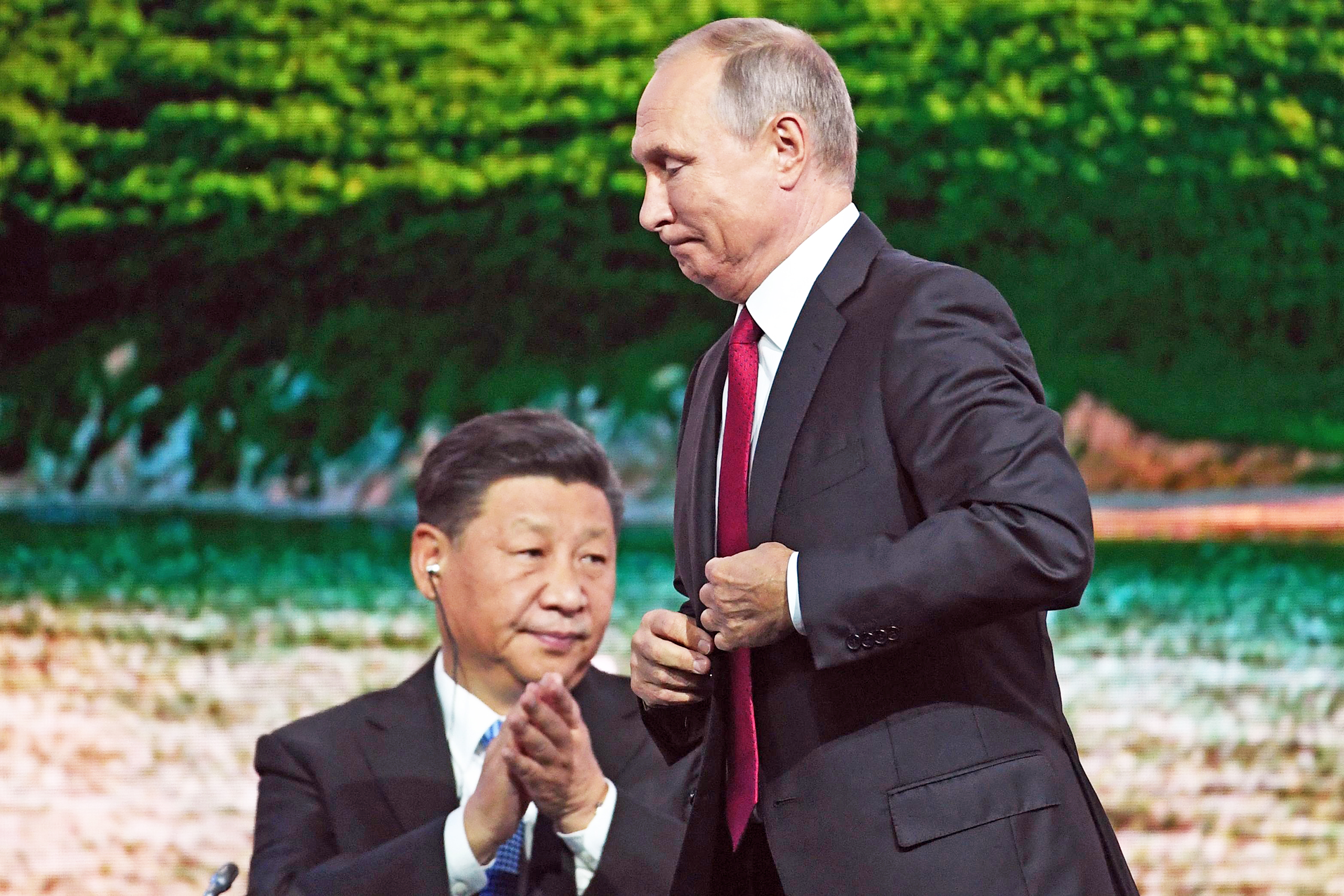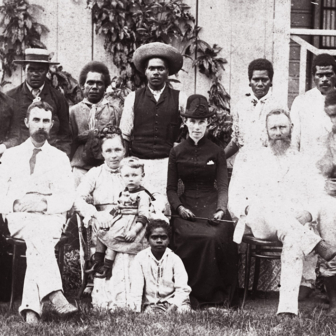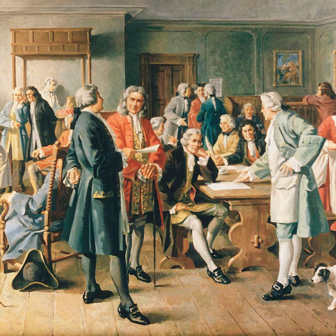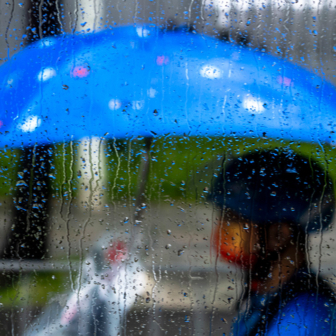After a distinguished career in the Department of Foreign Affairs and Trade, Geoff Raby has become a consultant and widely published commentator on the dovish side of the debate about China’s ambitions. His latest book, Great Game On: The Contest for Central Asia and Global Supremacy, a readable and thought-provoking mixture of history and musings on geopolitics, is enlivened by vignettes of his travels as Australian ambassador to that country and as a private tourist to several of the places under study, especially Xinjiang.
Raby’s theme is the competition and occasional conflict between the two great powers of Eurasia, China and Russia, in Xinjiang, Afghanistan, former-Soviet Central Asia, Mongolia and the Russian Far East. Underlying his impressive work of synthesis is the view that Eurasia “is the hinge of the global order”: whoever controls that region exerts outsized influence across the globe.
As Raby’s background might suggest, Great Game On is much stronger and more detailed on the Chinese side of the story. Indeed, its subtitle is something of a misnomer: the book is not really about Central Asia as usually defined, which takes in the five Soviet-era “Stans” — Kazakhstan, Uzbekistan, Turkmenistan, Kyrgyzstan and Tajikistan — colonised by Russia in the nineteenth century. Only one full chapter is devoted to Russia and China in Central Asia proper.
Raby does touch on the “Stans” in an opening chapter that presents the nineteenth-century “Great Game” between Britain and Russia as an example of how false assumptions, groupthink and worst-case scenarios distort policy-making. In retrospect, it does indeed seem ludicrous that the British feared Tsarist Russia would push down from its Central Asian colonies in Turkestan with aims to conquer Afghanistan — good luck! — en route to threatening Britain’s hold on its Indian Raj. Raby believes the same overblown anxiety about China and its current “axis” with Russia is clouding attitudes in Australia and the West in general, a point to which we’ll return.
To its benefit, Great Game On focuses a lot more on Chinese relations in the broad with Russia, the Soviet Union and those inner-Asian regions at the edges of the two continental superpowers’ spheres of interest. This arc from Afghanistan to Vladivostok he labels “Core Eurasia.” It makes sense to fit both Afghanistan and Chinese Xinjiang — if not Mongolia and the Russian Far East — into a broader definition of “Central Asia,” given their ethnic, religious and cultural links.
The book’s sections on Xinjiang and the Russian Far East are among its more illuminating. Raby highlights the extent to which, at times, Moscow’s influence on Xinjiang was greater than Beijing’s during the nineteenth and early twentieth centuries. Stalin in particular used the Soviet Union’s Central Asian peoples as a springboard for fomenting separatism in Xinjiang before 1945.
More recently, a priority for Beijing in relation to both Afghanistan — including early normalisation with the Taliban — and the Central Asian “Stans” has been to modify the threat of Islamist terrorism or any encouragement of Uighur separatism in Xinjiang. Russia, with its significant Muslim population and as many as ten million immigrants from Central Asia, shares China’s interest in staunching the flow of Islamist radicalism from the region. Here, Raby doesn’t shy away from noting that China’s own repressive policies in Xinjiang often counterproductively breed discontent.
Raby identifies China’s grievances over its loss of Far East territory in the Treaty of Aigun (1858) and Convention of Beijing (1860) as its most abiding bone of contention with Russia. China still regards them as “unequal treaties” of the same ilk as Britain’s acquisition of Hong Kong. They are the only ones still in force. Under this “Amur Annexation,” the Qing Empire ceded a region nearly the size of South Australia, bounded by the Amur and Ussuri rivers and the Pacific Ocean.
Raby underscores the depth of Chinese bitterness over these “lost territories.” He points out that official Chinese maps are now required to use the old Chinese names for places like Vladivostok rather than transliterations of Russian names. Particularly telling is his recounting of a recent dinner with retired senior Chinese professionals who vented about the injustice of the Russian nineteenth-century land grab. Given that China’s economic interests and presence in the Russian Far East are only likely to get stronger, local grievances may help make this dimension of the relationship harder to handle.
Disputes over the Far East — Outer Manchuria in Chinese nomenclature — are one of many sore points in the history of the evolving relationship. The latent antagonisms that appeared early on between the two Communist behemoths from 1949 broke into an open split in the 1960s, culminating in serious border clashes — and setting the scene for the US–China rapprochement initiated by Richard Nixon and Henry Kissinger.
But the years since the fall of the Soviet Union in 1991 have seen a gradual rapprochement and strengthening of ties between Beijing and Moscow. As Russia’s relations with the West deteriorated, particularly after Russia’s invasions of Ukraine in 2014, that process has redoubled. Both Xi Jinping and Vladimir Putin have enthusiastically forged a closer embrace, warmer than ever with declaration of a “partnership without limits” just before Russia’s February 2022 full-scale invasion.
Since then Russia has increasingly become the junior partner. China buys nearly 50 per cent of Russian oil exports and helps in other ways to avoid sanctions. The book doesn’t mention it, but one study estimates China sells Russia around A$460 million monthly in dual-use equipment — from machine tools to microchips — vital to make weapons for its war on Ukraine.
In the long run, Raby sees the present partnership as more a temporary “concert of convenience” than a relationship built on enduring foundations. Inherent weaknesses and longstanding fractures will make it hard to sustain. As noted, he seeks to defuse excessive worry about China and Russia leading an “axis of authoritarians” embracing North Korea, Iran and other disruptive powers. It is an anxiety that harks back to the early days of the Cold War, and even later to the Sino-Soviet split: old Canberra hands tell of a 1980 lunch where a senior Soviet diplomat warned Australian officials “one day we Russians will get back into bed with the Chinese and then we will screw the West from both ends.”
Calming “Chussia Anxiety” is the fulcrum of Great Game On’s geopolitical musings, but also one of its less convincing parts. Raby embraces the Realist approach to Great Power politics which rests on the view that, borrowing Thucydides, “the strong do what they can and the weak suffer what they must.” Ethnical norms and values are barely relevant.
Raby portrays Russian and Chinese expansionism and empire-building as expressions of rational self-interest, inevitable reactions to historical experience. He embraces the common belief that fear of invasion from the East was hard-baked into the DNA of Russian rulers after the trauma of the thirteenth-century Mongol invasions and subsequent domination by Mongol–Tatar khans for two centuries. This experience, goes the argument, impelled Russia to push outwards at a rapid pace to keep secure.
But ego, competition for status, pride, politicking, ideology and chauvinism factor into foreign policies, not just calculations of abstract national interest. Indeed, Raby recognises that expansion for its own sake was also a matter of pride and status for rulers and elites. Russia competed with other European powers for imperial greatness, imbued with similar prejudices about civilising inferior peoples. Raby also notes that China seeks a status-driven dominance globally — to be accepted as first among equals among advanced countries. Some supposedly baked-in security fears often morph into, or are no more than, myths and self-serving narratives or excuses.
The story of the Mongol–Tatar “yoke” has elements of the latter. Ukrainians could point out that the lands of today’s Ukraine suffered far more under Mongol rule than did Muscovy. And Moscow, just a backwater town when Genghis Khan’s grandson invaded in 1238, grew to become the pre-eminent principality in the region thanks to adroit politicking with the Mongol–Tatar khans to whom it owed suzerainty (but was not occupied by). Moscow used the khans to extend its sway and subordinate neighbouring Slavic fiefdoms. This was the springboard for Muscovy’s ascent and evolution into the Tsardom of Russia, which claimed inheritance of the former Rus’ principality centred on Kyiv and today’s Ukraine.
Similarly, those who say Russia has special security needs in the light of the trauma of the Second World War forget that Nazi Germany occupied Ukraine in its entirety but only 7 per cent of Russia. Ukraine also lost a larger proportion of its people than did Russia.
One of Great Game On’s more dubious claims is that Russia’s invasion of Ukraine reflects a longer-term quest to expand in order to keep secure and safe. This is in line with a Realist “don’t poke the bear” argument that allowing or encouraging Ukraine to move out of Russia’s self-appointed sphere of influence was as much or more to blame for the invasion as Russian aggression.
But while the Kremlin made a lot of noise about NATO expansion, its actions stem more from a neo-imperial view that Ukraine, like Belarus, is part of Russia’s patrimony. The decisions of non-Slavic neighbours such as the Baltic states and Finland to join NATO or the European Union were far less problematic. This attitudes harks back to the Tsarist ideology of the “triune” Russian nation, of Great Russians, Little Russians (Ukrainians) and White Russians (Belarusians).
The idea that Russia had to expand because, as Raby puts it, “in its experience, restraints on power spelled catastrophe,” isn’t borne out by history. Russia’s expansion eastwards across Siberia wasn’t driven by potential threats but by a quest for furs and other riches, and met little effective resistance from indigenous peoples. Its drive into Central Asia was about imperial grandeur as well as shoring up an extended southern border. Its bloody subjugation of the mountain peoples of the Caucasus was pure imperialism alongside competition with Persia and the Ottomans.
Likewise, the conquests of Ukraine and Crimea were part of the extended subjugation of Poland and a long struggle with the Ottoman Empire for dominance around the Black Sea. If Russia suffered occasional raids or attacks from the West (as it did from Poland in 1611–12 or Napoleon in 1812) other countries in Europe suffered far more devastation: for example, the German Holy Roman Empire lost a third or more of its population, as many as eight million, in the Thirty Years War of 1618–48, which involved predations by several outside powers. The Russian army first attacked Berlin in 1760.
China’s approach to achieving security may seem less abrasive, but it isn’t too different in major respects. For one, China hasn’t decolonised, unlike Russia where the fall of the Soviet Union saw fourteen ex-colonies leave and the prospect of non-Slavic ones being forced back seems slim. With no ex-colonies to interfere in, China is still at the stage of redressing perceived colonial grievances and would reject the notion that it is an empire. The non-Han peoples of Xinjiang and Tibet might think differently, and Inner Mongolia was also a colonised territory.
Moreover, for China to push claims over “lost territories” in the Russian Far East would be little different from Russia annexing parts of Ukraine, or the German Second or Third Reich’s claims to Alsace-Lorraine or the Sudetenland. Chinese claims are, in fact, weaker than many such assertions: very few Chinese lived in the Russian Far East, or Outer Manchuria as it is sometimes called, when Russia acquired it. Chinese control over the area came with the Manchu Qing dynasty, which established its rule over China in the seventeenth century. The Qing, who claimed but didn’t control or populate much of the Amur basin, signed a treaty in 1689 to establish borders with Tsarist Russia, which was moving into the area.
It might offend Chinese sensibilities, but one could suggest that Chinese claims to Taiwan, whatever its legal status, are in similar vein. Taiwan was only partially settled by Han Chinese, in rather imperial fashion, from the seventeenth century and then only controlled spasmodically by Beijing up to the Second World War. China’s assertion of rights over the South China Sea also reeks of an excessive attachment to its own historical claims.
Raby says that Russia’s invasion of Ukraine has scared the horses in Beijing because it contradicts a core principle of Chinese policy, respect for sovereignty. But that hasn’t stopped China pulling out most stops to help Russia’s war machine wreak maximum damage on lives and property. Different approaches to security and sovereignty don’t seem a barrier to a close partnership.
Despite his title, Raby doesn’t see Sino-Russian competition in Central Asia proper as an ongoing issue. He actually calls “game over” in Central Asia, with China’s sheer economic weight and Russia’s declining clout turning the former “Sovietstan” inexorably into “Sinostan.” But he wisely moderates — but simultaneously undercuts — this conclusion, recognising that the “Stans” will balance competing players, including others like Turkey, the European Union, India and the United States, to maximise their room for manoeuvre. And Russia, for historical, cultural and military reasons, will still have a major role. Its declining birth rate, in particular, means it will continue to rely on large-scale migration from Central Asia.
This “game over” call acquires heft in one of the book’s key judgements: “Having finally settled its security in Eurasia, China will be free to focus its strengths and assets on becoming the dominant global power, if it so chooses. It is now game on between China and the US-led West for global pre-eminence. Eurasia is the hinge of the global order.” This conclusion consciously echoes the precept of geopolitical pioneer Halford Mackinder that whoever controls the Eurasian heartland controls the world.
The centrality of the Eurasian or Central Asian hinge is unconvincing. No major strategic benefit from dominance in Central Asia is explained beyond some useful economic returns, as well as cooperation with the Stans and Afghanistan in stemming Islamist or separatist activity in Xinjiang. It hardly amounts to a solution to a huge border problem that otherwise would hold back China’s projection of military, political and economic power further afield.
Raby’s other final conclusion is possibly more compelling, but undercuts his initial attack on the Chussia Anxiety. He suggests we may be moving to a world of two “bounded orders”: one, led by the West, comprising countries with democratic or competitively systems; the other grouping authoritarian states, mostly from the Global South, under Chinese leadership. The gist seems to be that each order would have its own set of global political, security and financial institutions while also cooperating across the boundaries of these “orders” on a pragmatic basis.
But this takes us back full circle to the West versus the Axis of Authoritarians, the allegedly overblown and pessimistic idea identified with the Chussia Anxiety. And ultimately we seem to return to what is at bottom a China Anxiety, fears about which Raby has been keen to allay in other commentary. He contends that China is a “constrained superpower” inhibited by “its history and continuing territorial threats from within its border: namely, Xinjiang, Tibet, and also Taiwan and Hong Kong [and] its utter dependence on world markets.” The pros and cons of this argument are better debated in another place and by those more expert on China than I am.
Raby ends with a rather odd prescription for Europe — that it should look to the longer term and woo Russia back to the West and away from the Chinese authoritarian alliance by appealing to common cultural values rather than preaching about democracy. “It should stop belligerent speech and posturing that play directly into Putin’s hands.”
But a “reverse Kissinger” — weaning Russia away from China — in this manner doesn’t add up. Not only are the common European values that Russia has at times shared bound up with notions of democracy and human rights. Moreover, criticism of Russia’s invasion of Ukraine is directed not at Russia’s lack of democracy but its violation of the fundamental postwar taboo on territorial conquest, as well as countless egregious war crimes. This is hardly posturing or belligerence.
Putin has portrayed criticisms of his government’s behaviour as incorrigible Western hostility, even a desire to destroy Russia. His state media outlets have poured out such spleen for fifteen years, becoming a torrent since the 2014 invasions. State propaganda paints the invasion of Ukraine as a war in defence of a righteous, Orthodox Russia, imbued with healthy traditional values (albeit contrasting with bleak reality). Russia is pitted against a decadent West, corrupted by excessive liberalism, feminism and LGBTI+ ideology. Some ideologues even identify Russian civilisation as having special “Eurasian” characteristics!
Abstaining from lecturing on democracy and human rights will make little difference to the Russian people’s perceptions. It will take massive change inside Russia to move it onto a different path. In this respect, barring extraordinary acquiescence by Donald Trump in Russian aggression, mutual interests are likely to keep the Chussia partnership going.
As noted in a lecture by Kyle Wilson, an ANU and ex-Foreign Affairs colleague with considerable experience of both Russia and China, their mutual distrust is in fact a strength: both sides have a grasp of the other’s worldview and can feel confident that their shared perceptions will abide for some years. •
Great Game On: The Contest for Central Asia and Global Supremacy
By Geoff Raby | Melbourne University Press | $34.99 | 240 pages




